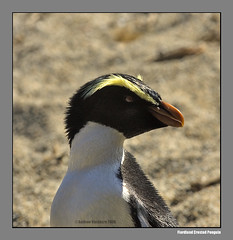GERMANY - As it was for Sandy from the musical Grease, the road to love has been a rocky one for Münster Zoo's 14-year-old African penguin Sandy. Now zoo staff are hoping she has finally found her real Danny Zuko.
Her first crush was destined for failure when at a young age she fell for her human zookeeper Peter Vollbracht. Despite their species differences, she stayed faithful to him for 10 years, following him around and completely ignoring the zoo's other penguins.
"There was nothing we could do about it. I didn't choose her; she chose me," Vollbracht told Spiegel Online. "She didn't care about anyone else. I was just her big penguin."
But in 2006, Vollbracht got sick and had to stay away from work for six weeks, leading the lonely Sandy to move on to Tom, a much younger male penguin. In 2008, after a few unsuccessful mating seasons, they had two chicks together. Then, sadly, in 2009, Tom died of a bacterial infection. Sandy was unable to raise the chicks by herself so the zoo put them in foster nests.
After Tom died, widow Sandy returned to her first love, Vollbract. "I came back to work from vacation, and it was like she'd flipped a switch. She was looking for someone, and I was there," the zookeeper told Spiegel Online at the time. "It's nice for the zoo and to be followed around again, but I can't stay her partner forever. We can't find her a partner. She chooses, and it's her decision or nothing."
And now, it looks like she has made that decision, this time choosing sticking with her own species. Hermann is an older penguin who may bring some maturity to the relationship. Zoo staff are also hoping that Sandy won't get distracted by another younger penguin, and that Hermann will stay alive for a while longer yet.
"Up to now, she’s hasn’t really had that much luck with men," zoo spokesperson Ilone Zühlke told The Local.
She may have not had much luck, but at least she's hopelessly devoted to love.
Sources
Picky penguin gets her man back by Josh Ward, 3 November 2009, Spiegel Online
Sandy the penguin finds love among her own kind, 14 February 2011, The Local
Her first crush was destined for failure when at a young age she fell for her human zookeeper Peter Vollbracht. Despite their species differences, she stayed faithful to him for 10 years, following him around and completely ignoring the zoo's other penguins.
"There was nothing we could do about it. I didn't choose her; she chose me," Vollbracht told Spiegel Online. "She didn't care about anyone else. I was just her big penguin."
But in 2006, Vollbracht got sick and had to stay away from work for six weeks, leading the lonely Sandy to move on to Tom, a much younger male penguin. In 2008, after a few unsuccessful mating seasons, they had two chicks together. Then, sadly, in 2009, Tom died of a bacterial infection. Sandy was unable to raise the chicks by herself so the zoo put them in foster nests.
After Tom died, widow Sandy returned to her first love, Vollbract. "I came back to work from vacation, and it was like she'd flipped a switch. She was looking for someone, and I was there," the zookeeper told Spiegel Online at the time. "It's nice for the zoo and to be followed around again, but I can't stay her partner forever. We can't find her a partner. She chooses, and it's her decision or nothing."
And now, it looks like she has made that decision, this time choosing sticking with her own species. Hermann is an older penguin who may bring some maturity to the relationship. Zoo staff are also hoping that Sandy won't get distracted by another younger penguin, and that Hermann will stay alive for a while longer yet.
"Up to now, she’s hasn’t really had that much luck with men," zoo spokesperson Ilone Zühlke told The Local.
She may have not had much luck, but at least she's hopelessly devoted to love.
Sources
Picky penguin gets her man back by Josh Ward, 3 November 2009, Spiegel Online
Sandy the penguin finds love among her own kind, 14 February 2011, The Local




